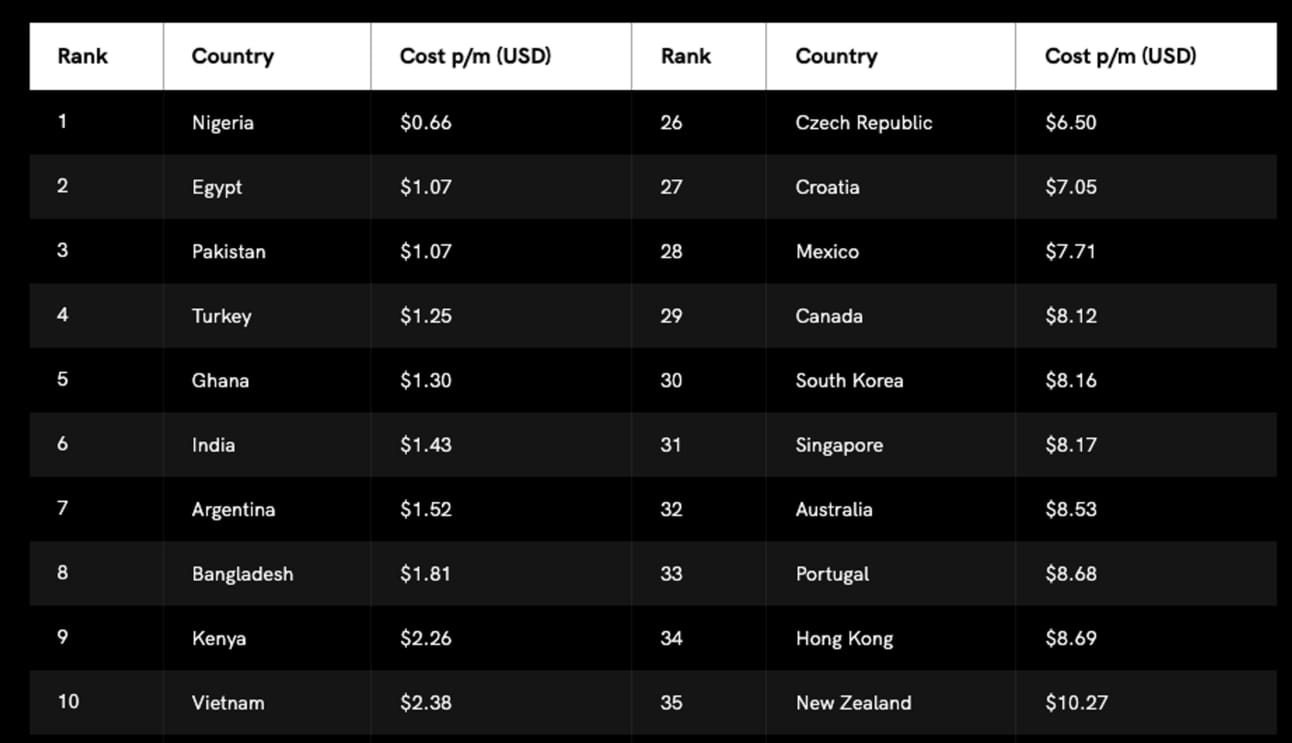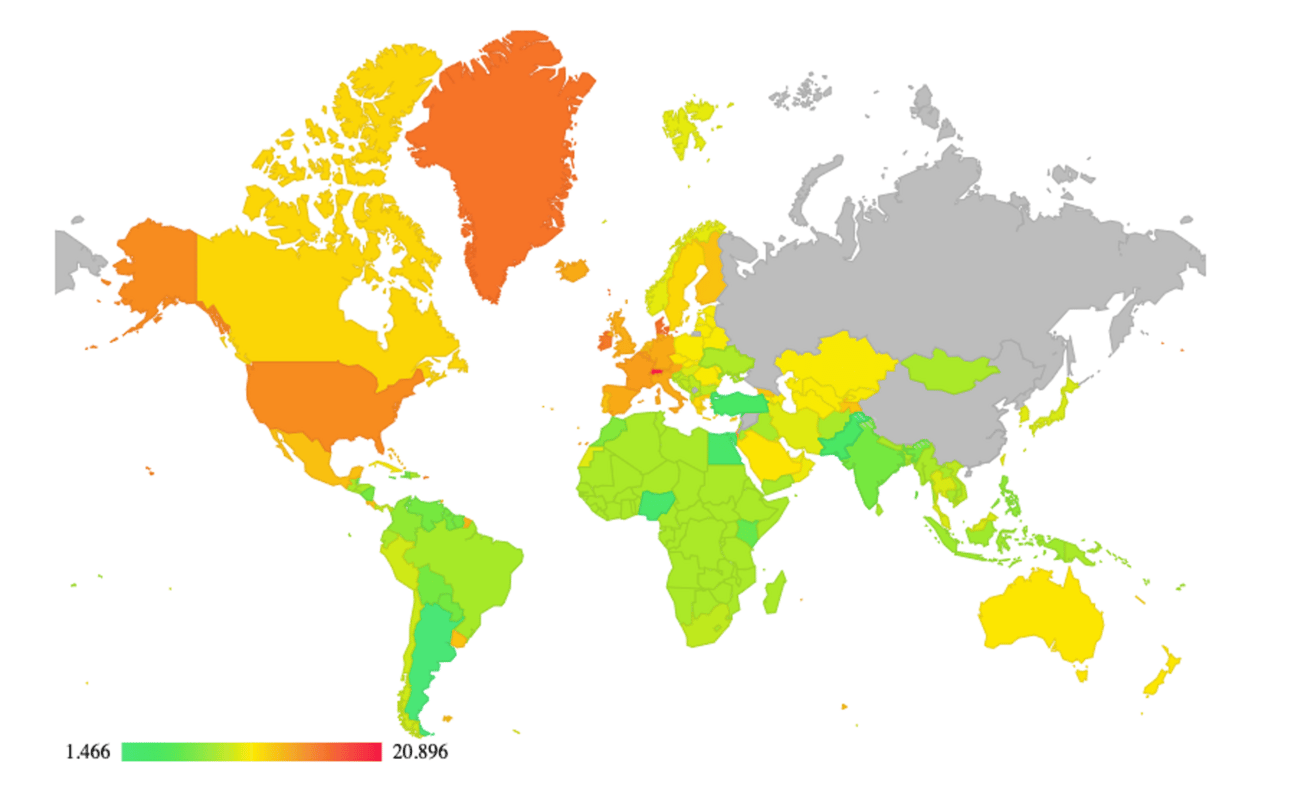
There is no easier way of making more money than just charging more for your product if your users will pay it. Sometimes, it really is that easy.
In the growth phase of all consumer startups, they start to (rightly) question if they are priced “correctly”.
When you head down this path, you might learn that you are prices “correctly” in some parts of the world, but not others.
If you are a US based tech company, you're probably realizing that your prices are way too expensive for people across the world.
If you are based in a developing country, you’re probably realizing that people in countries will pay much more for the same product.
This week we’re going to dive into the topic of setting up “price localization” or the practices of charging different amounts based on the country that your users are in.
An Overview of Price Localization
If you are thinking about making a push to acquire more paid users in outside of your country, there are four core thing that you have to get right within pricing and payments:
The currency that you display in the product
The value that your are charging
The payment methods that someone can pay with (e.g credit, debit, G Pay, etc)
Your payment processing infrastructure
This post is going to dive into #1 and #2 from this list., however you should keep in mind that #3 and #4 are also very important.
When I was at Codecademy, we internationalized our prices and saw material increase in the number of purchases happening in those countries.
This was one of many thing that we were working on at the same time, so we took a relatively simple approach:
Pulled a list of every country's GDP
Dumped it into an excel sheet
Sorted it from highest to lowest
Cut it into 5 buckets, roughly equal in size.
Raise prices on the top 2 buckets, kept the middle 2 the same, dropped the bottom one.
In retrospect, this was a fine approach but not a great one. It helped us get to the next level of revenue, but I wouldn’t do exactly this again.
If you look at most major consumer products, they have all set up price localization to help unlock revenue growth in that country.
If you use a VPN in an incognito browser, you might find a host of different price levels for products that you use every day.
Netflix, for example has set up country level prices, where the most expensive country, Switzerland, pays 7.6x what the cheapest country, Pakistan, pays.

Spotify also has a wide range of prices per country, with the most expensive country, Denmark, paying 24x the cost of the cheapest country, Nigeria.

(Just a note that both of these products have costs associated with providing their service and are also likely restricting the content that users in these countries can access, both of which impact price)
How should this work?
If I were to do this again, I think we should have based our methodology around relative purchasing power of our target users and not the country overall.
Staying in the Codecademy example, there were countries that had a stronger GDP overall, but engineering salaries weren’t proportionally as high.
There were also countries with higher paying (sometimes remote) engineering jobs but didn’t have as strong of a GDP.
What matters in the end is the level of affordability and perceived value of your product in that country for your ideal user.
If you are building a consumer product, it's pretty eye opening to look at the average salaries per country for people you might be trying to sell a product to.
Let's take a "marketing manager", for example, who is interested in purchasing a Reforge membership for $1,995 USD per year and also look at this as a % of their yearly salary.
In the United States marketing managers on average make $154,266 (USD)/yr and the cost of a Reforge membership is 1.3% of their salary
In Israel marketing mangers on average make about $95,600/yr and the cost of a Reforge membership is 2.1% of their salary
In Argentina marketing mangers on average make about $18,524.13/yr and the cost of a Reforge membership is 10.7% of their salary
For US based employees, a Reforge membership comes out to $166.25 per month and puts it on the same level of a fancy gym or a nice dinner out.
For Israeli marketers, its a materially more expensive, but not out of reach if you think the investment is worth it.
For Argentinian based marketing manager, you are asking for multiple months of rent. This is materially different and will definitely hinder your growth in that country.
(Just a note that Reforge is likely localizing their prices and I just can’t see it. This isn’t meant as a criticism of Reforge but as an illustrative example)
A Word of Caution
It's tempting to look up the geographic location of your users and start to dream up all of the different pricing plans that will unlock the next level of growth for your company.
Localizing prices is a tactic that has been proven to work, but it's not a simple one. It takes both time to research and set up.
However, the biggest cost is that it massively increases the complexity within your product and operations, which drags down your velocity.
The complexity tax is real and geographic based prices adds material complexity, which means that you have to pay this tax in a host of new areas across your business.
When someone reaches out to customer service, your team has to know what price plan that person users
Whenever you design a new pricing page, you have to accommodate different character counts for your prices
Financial forecasts for the year now need to be country specific.
Any place in your product that show price now has to account for a range of character counts in the design.
Ad campaigns need to take into account that certain users have materially different LTVs based on their country. Additionally, any ad copy that mentions prices has to be country specific.
All of these are solvable problems, but they are new problems that you have now introduced to your business and have to deal with.
Additionally, this opens up a new set of safeguards that you have to monitor, namely people using VPNs to get a cheaper prices.
If you are a super high margin software company, this might not matter. However, if you have material costs to provide your product, then you have to find ways of controlling for this.
So What Should You Do With This Information?
Before writing this blog post, I normally would describe price internationalization as one of the later stage growth tactics that you should use due to the increased complexity.
The more I explore this and see companies implement this tactic, I now think is is more appropriate for the medium stage of growth.
This is something that you should consider when you think the following things are true:
You have figured out strong product market fit, your initial growth channels work and are now scaling.
Your product is priced out of reach for a large portion of your users by a wide margin.
Unlocking those users will materially impact your growth.
You can handle the increase in complexity operationally.
Each business would define “material” growth impact a bit differently, but the floor for this number feels like unlocking 15-20%.
This is the type of project that deserves due diligence and planning. Additionally, this is going to be a mix of art and science.
It unlikely that you’ll be able see crystal clear patterns in your data and you’ll have to go partially off of instinct.
I’d suggest something like the following process.
1. Download a list of your users per country
Determine how many users you have in each country in the world and drop it into a spreadsheet.
Make sure you’re somehow controlling for high intent users or leads that are coming back to your product but not purchasing. This is a bit different for each company.
If you went viral in Pakistan 6 years ago and have a bunch of emails registered from that period, you should probably ignore that.
The intent of this process is to find place you can expand revenue, so you need recent & high intent interest.
2. Find the best proxy for purchasing power for each country
I personally like the concept of your prices as a % of that person’s monthly salary. This might not be perfect, but it feels like a good place to start.
You want to find a rough way of determining how relatively “expensive” that your product is for users in that country. Add this data to your spreadsheet. You’ll probably have to make a lot of assumptions, that's fine.
If you can find a good proxy for the demand for your product, you should factor that in as well. Competitor pricing can be one input here, but getting a really clear signal will be hard.
3. Sort Your Sheet
Don’t kills yourself trying to build custom plans for every country where you have some demand, so you want to sort your sheet so you can group like countries together.
Whatever proxy for purchasing power you end up going with, sort the sheet by that. Exclude countries that you don't have enough users in.
4. Groups those countries into tiers
To avoid killing yourself with unnecessary complexity, group the countries that you have demand into rough tiers where every country in that tier should have the same price.
If you look at the below heat map in the world (which is based on Netflix’s prices in 2024) you can see that roughly the following buckets emerge.
US + Western Europe are the most expensive
Eastern Europe, Australia, Canada, are next
India, Most of South America, Africa, Southeast Asia are the cheapest
These buckets and roughly ordering feel approximately right for me, however don’t take this as gospel. You might be different.
I am using Netflix data only because its public, they have a lot of other considerations (such as content cost, competition, etc).

Netflix prices by country from https://vpnwiki.com/en/netflix-subscription-prices
5. Determine relative cost between tiers
Take, what is probably an educated guess, at how much each tier should cost in relation to each other. As mentioned above, this is going to be a lot more art than science.
If you have the time to run country level pricing research, that can help. For most startups however, you need to move faster than that and you should try to keep each country/tier in the same rough range of purchasing power.
6. A/B Test This or Just Release it
If you have the resources (and traffic), this is something that you can A/B test to determine if this is the right move. That said, what you're really betting on here is that this will unlock more growth in these countries, which will probably be measured in years not weeks.
If you want to just change this and measure it, that approach works too. A good northstar number to measure is probably something like Average Revenue Per User (ARPU) in those countries or tiers.
Regardless of what you choose, you will probably want to announce this in some form once, especially if you are dropping the price in a country.





